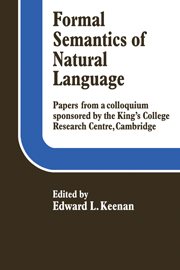Book contents
- Frontmatter
- Contents
- Notes on the contributors
- Acknowledgements
- Introduction
- I QUANTIFICATION IN NATURAL LANGUAGE
- II REFERENCE AND CROSS REFERENCE
- III INTENSIONAL LOGIC AND SYNTACTIC THEORY
- IV QUESTIONING MODEL THEORETIC SEMANTICS
- Model theoretic semantics and natural language
- Model theory and linguistics
- V PRAGMATICS AND SENTENCES IN CONTEXT
- VI SEMANTICS AND SURFACE SYNTAX
Model theoretic semantics and natural language
Published online by Cambridge University Press: 05 November 2011
- Frontmatter
- Contents
- Notes on the contributors
- Acknowledgements
- Introduction
- I QUANTIFICATION IN NATURAL LANGUAGE
- II REFERENCE AND CROSS REFERENCE
- III INTENSIONAL LOGIC AND SYNTACTIC THEORY
- IV QUESTIONING MODEL THEORETIC SEMANTICS
- Model theoretic semantics and natural language
- Model theory and linguistics
- V PRAGMATICS AND SENTENCES IN CONTEXT
- VI SEMANTICS AND SURFACE SYNTAX
Summary
My aim in this paper is to describe the ways in which model theoretic semantics is used in the study of formal languages, and thence to evaluate it as a tool for the study of natural language. I shall argue that model theoretic semantics is primarily valuable as a theory of consequence; and that, whilst as a tool for the study of natural language it enjoys certain philosophical advantages over other theories of consequence, the fashionable claim that it can provide a theory of truth and meaning for natural language is misguided.
From its conception in the 1930s model theory has led a double life. It has been at once an uncontroversial tool of formal logic and a controversial tool of philosophical and linguistic analysis (recently it has acquired a third and perhaps less transient life as an object with certain algebraic and topological properties of interest to pure mathematicians, see, e.g., Rasiowa and Sikorski (1963)).
To prepare the ground we categorize roughly the uses of model theory:
In the study of formal languages
A theory of truth value assignment and consequence;
A construction for proving metalogical theorems about independently defined formal systems;
A heuristic for the development and teaching of formal systems.
In the study of natural language
A theory of consequence;
An explication of certain connections between extension, truth value assignment and consequence;
A framework for the discussion of questions of ontology;
A theory of truth and meaning.
Information
- Type
- Chapter
- Information
- Formal Semantics of Natural Language , pp. 219 - 240Publisher: Cambridge University PressPrint publication year: 1975
Accessibility standard: Unknown
Why this information is here
This section outlines the accessibility features of this content - including support for screen readers, full keyboard navigation and high-contrast display options. This may not be relevant for you.Accessibility Information
- 1
- Cited by
